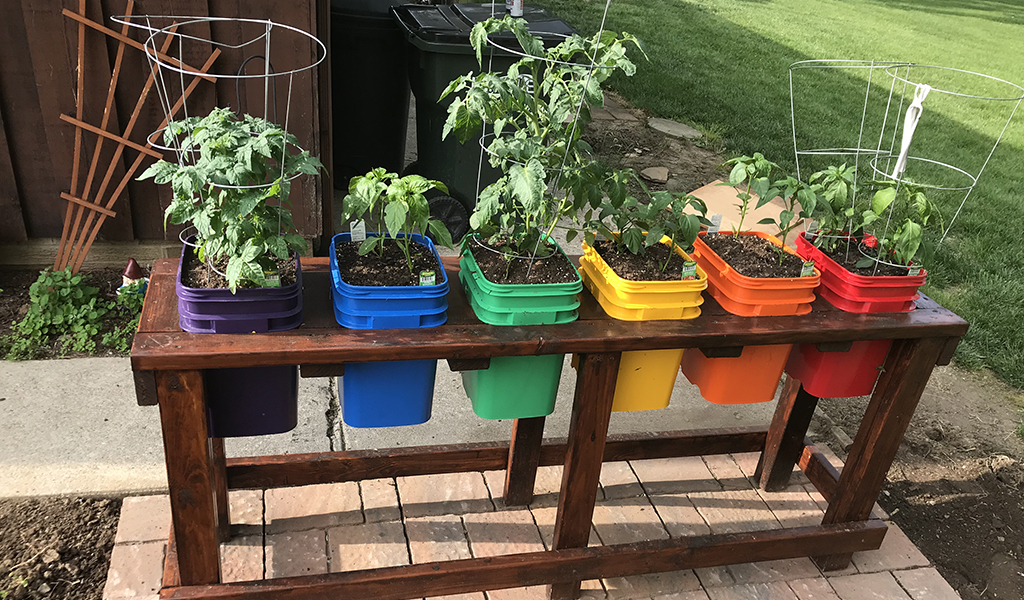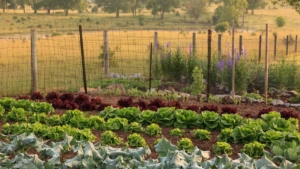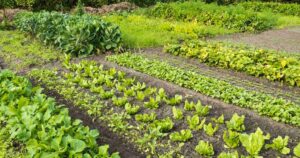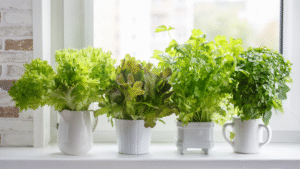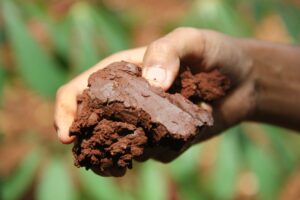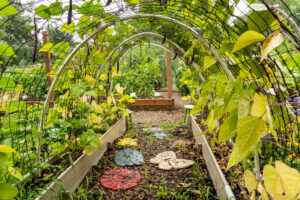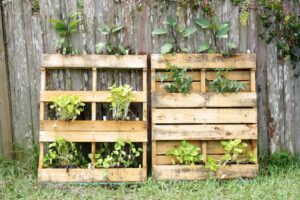Container Vegetable Garden: Transform Small Spaces into Productive Food Gardens
Growing fresh vegetables doesn’t require acres of land or even a traditional garden bed. Container vegetable gardening offers the perfect solution for apartment dwellers, those with limited outdoor space, or gardeners dealing with poor soil conditions. This approach delivers remarkable yields in minimal space while offering flexibility, accessibility, and creative expression. Whether you’re working with a small balcony, a sunny patio, or just a windowsill, you can create a thriving edible garden in containers that provides homegrown harvests throughout the growing season.
Why Choose Container Vegetable Gardening?
Before diving into the how-to, let’s explore the compelling advantages of growing vegetables in containers:
- Space Optimization: Grow food in limited areas like balconies, patios, driveways, and windowsills
- Soil Quality Control: Bypass poor native soil by creating the perfect growing medium
- Mobility: Relocate plants to follow the sun or protect from extreme weather
- Accessibility: Elevate gardening activities for those with physical limitations
- Pest Management: Reduce ground-dwelling pest problems and control growing conditions
- Extended Seasons: Move containers indoors/outdoors to extend growing periods
- Design Flexibility: Integrate edibles into decorative landscapes or create dedicated food-growing zones
- Reduced Maintenance: Minimize weeding and maintenance compared to in-ground gardens
Essential Elements for Container Vegetable Gardening Success
Creating a productive container vegetable garden requires understanding several key components that work together to support plant health and productivity.
Container Selection: From Traditional to Repurposed
The vessels you choose for growing vegetables significantly impact plant health, maintenance requirements, and overall success. Consider these factors:
Traditional Container Options
- Terracotta Pots: Classic choice with excellent breathability
- Pros: Natural appearance, good aeration
- Cons: Heavy, breakable, dry out quickly, can be expensive
- Best for: Herbs, plants preferring drier conditions
- Plastic Containers: Versatile and widely available
- Pros: Lightweight, affordable, retain moisture well
- Cons: Can degrade in sunlight, less breathable
- Best for: Moisture-loving vegetables, beginners
- Fabric Grow Bags: Modern solution for healthier roots
- Pros: Excellent drainage, promotes air pruning of roots, foldable for storage
- Cons: Dry out quickly, can look less decorative
- Best for: Root vegetables, plants prone to root diseases
- Wooden Planters: Attractive option with natural insulation
- Pros: Aesthetically pleasing, good insulation for roots
- Cons: Eventual rot, potential chemical treatments in some wood
- Best for: Mixed plantings, decorative vegetable displays
- Self-Watering Containers: Low-maintenance solution
- Pros: Reduced watering frequency, consistent moisture
- Cons: Higher initial cost, can promote root rot if overwatered
- Best for: Vacationing gardeners, consistent moisture-loving plants
Repurposed & DIY Containers: Economical Solutions
Transforming everyday items into productive growing containers offers budget-friendly alternatives with unique aesthetic appeal:
- Food-Grade Buckets: 5-gallon buckets make excellent planters
- Preparation: Drill drainage holes, clean thoroughly
- Best for: Larger plants like tomatoes, peppers, eggplants
- Cost: Often free or under $5
- Plastic Storage Totes: Convert into mini raised beds
- Preparation: Add numerous drainage holes, reinforce sides if needed
- Best for: Shallow-rooted crops like lettuce, spinach, radishes
- Cost: $5-15 depending on size
- Reused Shipping Pallets: Create vertical gardens
- Preparation: Sand rough edges, line with landscape fabric
- Best for: Vertical herb gardens, strawberries, trailing plants
- Cost: Often free from businesses
- Milk Jugs & Plastic Bottles: Perfect for small herbs and seedlings
- Preparation: Cut tops, add drainage, remove labels
- Best for: Herbs, microgreens, individual lettuce plants
- Cost: Free
- Disposable Food Containers: Repurpose takeout containers
- Preparation: Add drainage holes, ensure adequate depth
- Best for: Seed starting, small herbs, shallow-rooted vegetables
- Cost: Free
- Food Cans: Colorful additions to small spaces
- Preparation: Remove labels, add drainage, sand sharp edges
- Best for: Individual herb plants, decorative arrangements
- Cost: Free
Important Considerations for Any Container:
- Drainage: Essential for plant health—every container needs adequate drainage holes
- Size: Minimum 6-8 inches deep for leafy greens; 10-12 inches for most vegetables; 12+ inches for tomatoes and root crops
- Material Safety: Ensure containers haven’t held toxic substances and won’t leach harmful chemicals
- Durability: Consider how the container will withstand weather conditions in your climate
- Weight When Filled: Account for the weight of soil, water, and mature plants when positioning containers

Container Vegetable Garden Soil: The Foundation of Success
Unlike traditional gardens, container growing allows complete control over soil quality. The growing medium in containers serves multiple functions:
- Anchors plant roots
- Provides essential nutrients
- Retains appropriate moisture
- Allows adequate aeration for root health
- Drains excess water effectively
Creating the Ideal Container Soil Mix
Standard garden soil is too dense for containers, leading to compaction, poor drainage, and potential disease issues. Instead, create or purchase specialized container mixes:
Basic DIY Container Mix Recipe:
- 60% high-quality potting soil (not garden soil)
- 30% compost for nutrients and beneficial microorganisms
- 10% perlite or vermiculite for improved drainage and aeration
For Vegetables With Higher Nutrient Needs:
- 50% potting soil
- 40% compost
- 10% worm castings or well-rotted manure
- Optional: ¼ cup balanced organic fertilizer per cubic foot of mix
For Root Vegetables:
- 50% potting soil
- 30% compost
- 20% coarse sand or perlite for better drainage
- Avoid high-nitrogen amendments
Cost-Saving Tip: Make bulk batches of container mix and store in covered containers for ongoing use throughout the season.
Light Requirements: Positioning Your Container Garden
Most vegetables require substantial sunlight to produce well. Assess your available space and match plants to appropriate light conditions:
- Full Sun Locations (6+ hours direct sun): Tomatoes, peppers, eggplants, cucumbers, squash, beans
- Partial Sun (4-6 hours direct sun): Leafy greens, root vegetables, herbs like parsley and cilantro
- Partial Shade (2-4 hours direct sun): Lettuce, spinach, kale, arugula, mint, chives
Mobility Advantage: Unlike in-ground gardens, containers can be repositioned to follow seasonal sun patterns or provide afternoon shade during extreme heat.
Backyard Container Vegetable Garden Ideas: Design Approaches
Container vegetable gardens can be both highly productive and visually appealing. Consider these design strategies:
Functional Groupings for Maximum Productivity
Organize containers based on plant needs for efficient maintenance:
- Kitchen Garden Cluster
- Group frequently harvested herbs and vegetables near cooking areas
- Include parsley, basil, chives, cherry tomatoes, and leaf lettuce
- Use decorative containers that complement house architecture
- Salad Garden Collection
- Combine various leafy greens in shallow, wide containers
- Stagger plantings every 2-3 weeks for continuous harvest
- Include edible flowers like nasturtiums for color and flavor
- Vertical Vegetable Towers
- Stack containers or use specialized vertical systems
- Position taller plants at the back/center
- Combine plants with similar water requirements
- Pollinator-Friendly Arrangements
- Intersperse flowering herbs like oregano, thyme, and borage with vegetables
- Include dedicated containers for flowers that attract beneficial insects
- Position near fruiting crops that benefit from increased pollination
Aesthetic Design Approaches
Create visually appealing container arrangements while maintaining productivity:
- Color Coordination
- Select containers in complementary or monochromatic color schemes
- Include vegetables with colorful foliage like purple basil or rainbow chard
- Add trailing nasturtiums or ornamental sweet potato vines for cascading elements
- Vertical Interest
- Incorporate trellises, obelisks, or stakes for climbing vegetables
- Create height variation with elevated platforms or stands
- Use hanging baskets for trailing crops like strawberries or determinant tomatoes
- Themed Container Gardens
- Pizza Garden: Tomatoes, basil, oregano, and peppers in coordinated containers
- Salsa Garden: Tomatoes, cilantro, peppers, and onions grouped together
- Tea Garden: Mint, chamomile, and lemon balm in vintage containers
- Edible Landscapes
- Integrate vegetable containers within ornamental plantings
- Use attractive containers that complement surrounding hardscape
- Include vegetables with ornamental qualities like rainbow chard, purple basil, and ornamental peppers
Cheap Container Vegetable Gardening Ideas: Budget-Friendly Approaches
Growing vegetables in containers doesn’t have to be expensive. These strategies maximize production while minimizing costs:
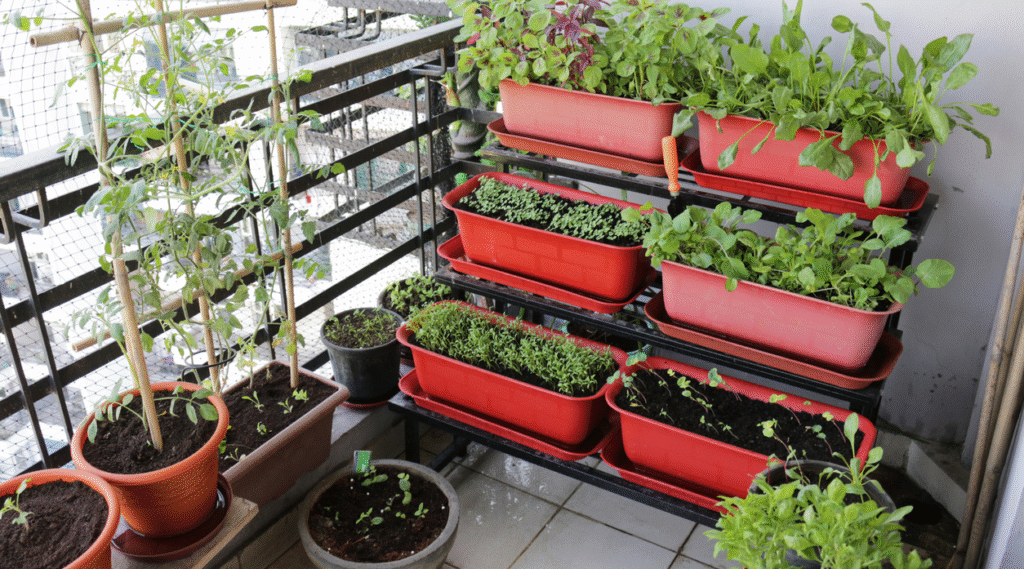
Economical Container Solutions
- Community Resource Networking
- Request buckets from restaurants, bakeries, or cafeterias
- Check online marketplace free sections for unwanted containers
- Join garden swap groups to exchange containers and supplies
- Bulk Material Purchases
- Coordinate with neighbors to buy soil components in bulk
- Split large bag purchases of potting soil and amendments
- Purchase end-of-season containers at clearance prices
- Multi-Purpose Containers
- Convert storage bins with lids into both growing containers and winter storage
- Use containers that can double as cold frames with added protection
- Select stackable containers for off-season storage efficiency
- DIY Container Projects
- Create self-watering containers from recycled plastic bottles
- Build wooden container boxes from reclaimed lumber
- Construct vertical pallet gardens for space efficiency
Budget-Friendly Growing Practices
- Water Conservation Techniques
- Install simple drip irrigation using inexpensive tubing
- Create water reservoirs from recycled plastic bottles
- Use milk jug ollas (buried vessels that slowly release water)
- Affordable Soil Management
- Start a compact compost system specifically for container gardening
- Practice vermicomposting for high-quality free fertilizer
- Use coffee grounds, eggshells, and banana peels as amendments
- Plant Propagation
- Save seeds from current vegetable plants for future seasons
- Divide perennial herbs to create new plants
- Root vegetable scraps like green onions and lettuce bases
Best Vegetables for Container Gardening
Some vegetables naturally perform better in containers than others. Consider these reliable performers for your first container garden:
Top Performers for Container Gardens
- Leafy Greens
- Lettuce (loose-leaf varieties)
- Spinach
- Kale
- Arugula
- Swiss chard
- Container needs: 6-8 inches deep, harvest outer leaves for continued production
- Herbs
- Basil
- Parsley
- Cilantro
- Mint (always grow in separate containers)
- Thyme
- Container needs: 6-8 inches deep, regular harvesting encourages bushy growth
- Fruiting Vegetables
- Cherry/Grape Tomatoes (determinate or dwarf varieties)
- Peppers (especially compact varieties)
- Eggplant (dwarf varieties)
- Container needs: 12+ inches deep, 5+ gallon capacity, support structures
- Root Vegetables
- Radishes
- Beets
- Carrots (shorter varieties)
- Green Onions
- Container needs: 10-12 inches deep for most, loose soil with excellent drainage
- Vining Crops (with appropriate support)
- Cucumbers (bush or compact varieties)
- Peas
- Beans (bush varieties are easier than pole types)
- Container needs: 10+ inches deep, sturdy trellising
Growing Vegetables in Containers Outdoors: Seasonal Care
Container vegetable gardens require specific care routines throughout the growing season to maintain productivity and plant health.
Planting and Establishment
- Spring Preparation
- Clean containers thoroughly if reusing from previous season
- Repair or upgrade irrigation systems before planting
- Position containers for maximum sun exposure during spring angles
- Planting Techniques
- Fill containers to within 1-2 inches of the rim
- Plant at appropriate depth for each vegetable type
- Apply light mulch layer to retain moisture and reduce soil splashing
- Early Establishment Care
- Monitor moisture daily for the first week
- Protect new plantings from extreme weather with temporary covers
- Hold off on fertilization until plants show active growth
Ongoing Maintenance Routine
- Watering Strategy
- Check moisture levels daily during growing season
- Water thoroughly until liquid runs from drainage holes
- Consider self-watering options for vacation periods
- Feeding Container Vegetables
- Apply liquid organic fertilizer at half-strength every 2-3 weeks
- Side-dress heavy feeders with compost mid-season
- Use compost tea for both nutrition and beneficial microorganisms
- Support and Pruning
- Install supports for taller plants before they need them
- Remove lower leaves of tomatoes and other plants for air circulation
- Prune to maintain appropriate size for container constraints
- Pest and Disease Management
- Inspect plants closely during regular watering
- Treat issues immediately with organic solutions
- Remove severely affected plants promptly to prevent spread
Seasonal Transitions
- Summer Heat Management
- Move containers to provide afternoon shade during extreme heat
- Increase watering frequency during heatwaves
- Apply additional mulch to reduce evaporation
- Fall Production Extension
- Insulate container sides with bubble wrap or burlap
- Use row covers for frost protection
- Move containers to south-facing locations for maximum late-season sun
- Winter Container Care
- Clean thoroughly after harvest season
- Store terra cotta and ceramic containers indoors to prevent cracking
- Prepare perennial herb containers for overwintering
Troubleshooting Common Container Garden Problems
Even well-maintained container gardens can face challenges. Here are solutions to frequent issues:
Moisture Management Issues
- Consistently Dry Soil Despite Regular Watering
- Causes: Container too small, potting mix repelling water, underwatering
- Solutions:
- Add water-retaining polymer crystals to soil
- Insert wicking system into container
- Apply mulch layer to reduce evaporation
- Consider larger container for affected plant
- Constantly Soggy Soil
- Causes: Poor drainage, overwatering, container too large for plant
- Solutions:
- Verify drainage holes are functioning
- Add additional drainage holes if needed
- Incorporate more perlite into soil mix
- Allow soil surface to dry before watering again
Nutrient Deficiencies
- Yellowing Leaves
- Causes: Nitrogen deficiency, poor drainage, root issues
- Solutions:
- Apply nitrogen-rich fertilizer or compost
- Check for root binding and repot if necessary
- Ensure proper drainage and watering schedule
- Poor Fruit Production
- Causes: Inadequate phosphorus, insufficient sunlight, improper pollination
- Solutions:
- Apply phosphorus-rich organic fertilizer
- Relocate containers to sunnier position
- Hand pollinate using small brush for indoor containers
Size and Growth Issues
- Stunted Plants
- Causes: Container too small, nutrient depletion, rootbound conditions
- Solutions:
- Transplant to larger container
- Refresh soil with compost and balanced fertilizer
- Trim roots and repot with fresh soil
- Leggy Growth
- Causes: Insufficient light, overcrowding, excessive nitrogen
- Solutions:
- Relocate to sunnier position
- Thin plants to recommended spacing
- Reduce high-nitrogen fertilizer applications
Project Showcase: Three Successful Container Vegetable Gardens
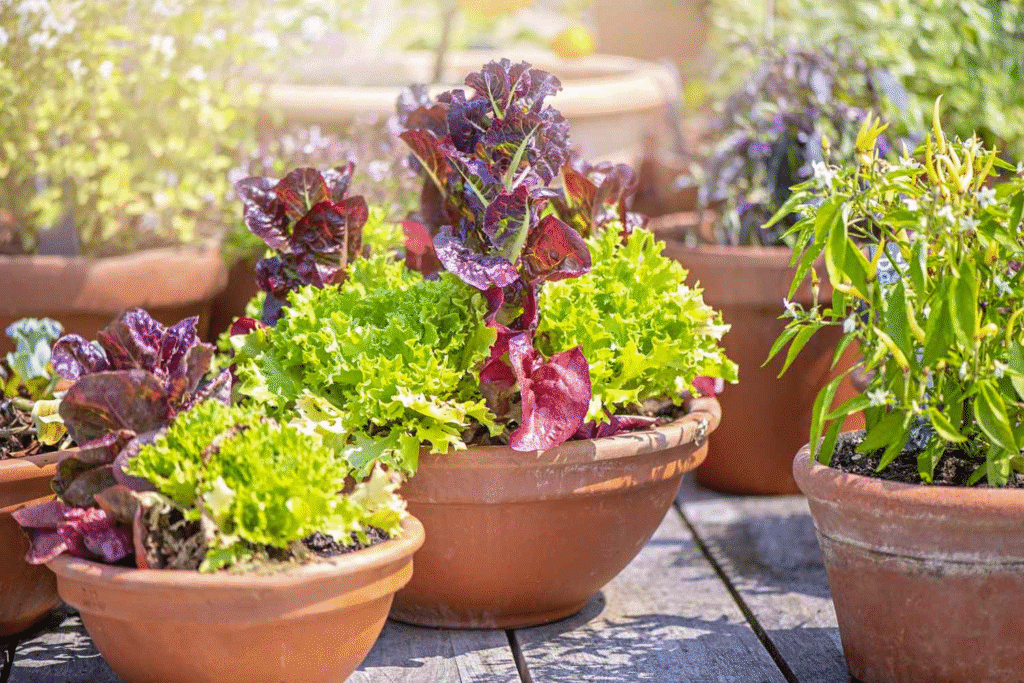
Urban Balcony Garden: Maximum Production in 50 Square Feet
Site Conditions: Full morning sun, afternoon shade, windy conditions Design Approach: Vertical emphasis with railing planters and stackable systems Key Containers:
- Railing planters for herbs and lettuce
- 5-gallon buckets for tomatoes and peppers
- Hanging baskets for strawberries and trailing herbs
- Vertical wall system made from plastic gutters
Special Features:
- Drip irrigation system with timer
- Folding trellises for temporary support
- Compact storage area for supplies
- All containers on rolling platforms for mobility
Results: Over 30 pounds of produce in a single season, including daily salad greens, herbs, and cherry tomatoes
Suburban Patio Garden: Decorative Food Production
Site Conditions: Full sun, limited space, HOA restrictions Design Approach: Ornamental edible landscape integrated with outdoor living space Key Containers:
- Decorative ceramic pots for peppers and eggplants
- Window boxes for herbs and compact greens
- Whiskey barrel planters for tomatoes
- Galvanized metal containers for root vegetables
Special Features:
- Container groupings that create outdoor room divisions
- Color-coordinated containers matching patio furniture
- Trellises doubling as privacy screens
- Elevated containers for easier maintenance
Results: Beautiful outdoor living space that produced over 50% of household vegetables during summer months
Rural Container Victory Garden: Budget-Focused Productivity
Site Conditions: Poor native soil, part sun/part shade, unlimited space Design Approach: Maximum production with minimum investment Key Containers:
- Repurposed plastic totes for root vegetables
- Food-grade buckets for tomatoes and peppers
- Wooden pallets converted to vertical planters
- Old wheelbarrow and washtub as featured containers
Special Features:
- Rain barrel water collection system
- Homemade compost tea fertilizer setup
- Season extension with recycled window cold frames
- Solar-powered drip irrigation
Results: Over 200 pounds of produce for under $100 investment in materials, 80% of containers acquired for free
Conclusion: The Evolving Joy of Container Vegetable Gardening
Container vegetable gardening offers an accessible entry point into food production for anyone with even minimal outdoor space. The flexibility, control, and creative potential of this approach make it ideal for both novice gardeners and experienced growers looking to maximize production in limited areas.
By starting with appropriate containers, creating nutrient-rich soil mixes, and selecting vegetables well-suited to container culture, you can establish a productive garden that evolves with your needs and interests. The mobility of container gardens allows adaptation to changing conditions and continuous experimentation with new growing techniques and plant varieties.
As you enjoy the fruits of your container garden, remember that each season brings new opportunities to refine your approach. The knowledge gained through direct experience with your specific growing environment is invaluable. Document your successes and challenges, adjust your methods accordingly, and share your discoveries with fellow gardeners.
Whether you’re harvesting sun-warmed cherry tomatoes from a balcony planter, snipping fresh herbs from a windowsill container, or gathering an abundant crop of peppers from recycled buckets, your container vegetable garden connects you to the timeless satisfaction of growing your own food—regardless of where or how you garden.
